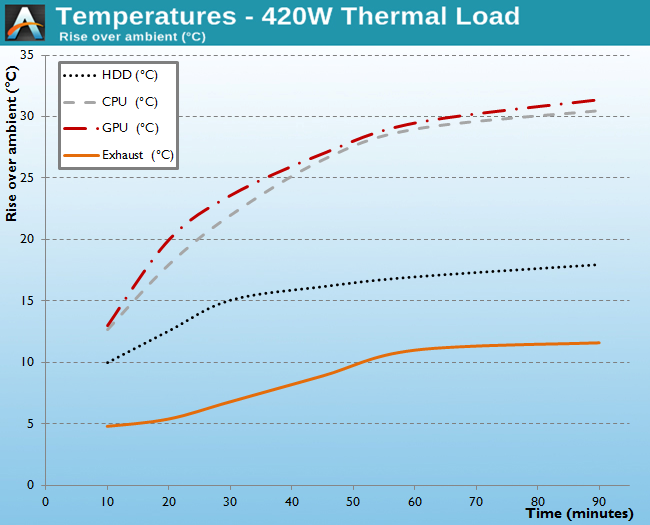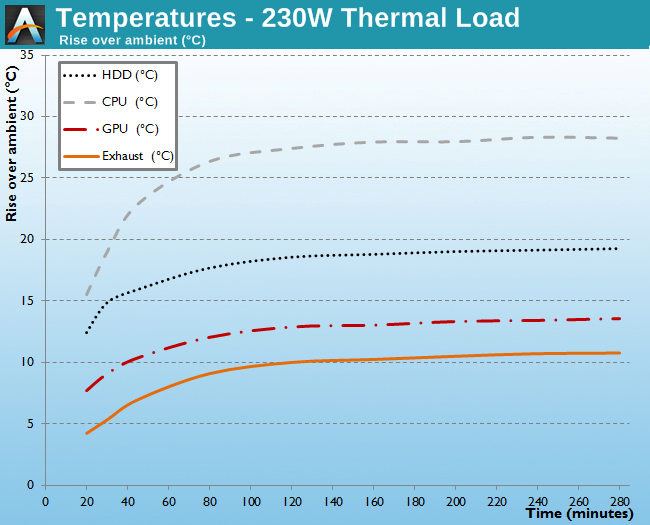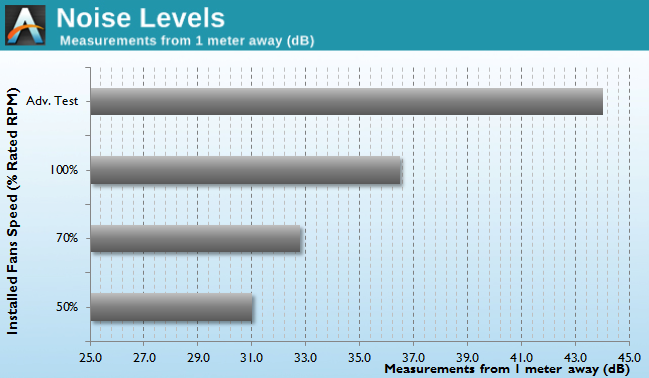Corsair Carbide Air 240 Case Review
by E. Fylladitakis on August 15, 2014 6:00 AM EST- Posted in
- Cases/Cooling/PSUs
- Corsair
- ATX
- Case
- Carbide
Test Setup
Professional testing requires the emulation of real-world situations but with repeatable results; thus, a perfectly controllable test setup and environment are required, especially for comparable results. Testing the thermal performance of any case with a typical real-world setup technically limits the comparability of the results to this setup alone, as an active system interacts with its environment and the change of a single component would alter myriads of variables. For our case reviews, we developed synthetic loads that emulate the thermal output of real systems, but these are passive, steady and quantifiable loads. This allows us to test the thermal capabilities of the case alone, as if it would have to deal with the entire thermal load by itself, regardless of what system an end user might install in it.
Laboratory data loggers are used to monitor the PT100 sensors and control the safety relays, which are fully accessible via our custom software. We have created three such loads, and we'll use the Micro-ATX load for this case. The Micro-ATX version simulates a 180W CPU, 40W VRM, 20W RAM, and 1 × 120W GPU card thermal load. Finally, two 3.5" HDD dummy loads have also been installed, with each of them converting 30W of electrical power to thermal. Note that the total load is generally more important than the individual elements, and the total thermal load of the Micro-ATX test setup is up to 420 Watts. As such, the thermal load is very high and only the best of cases will be able to handle it for more than a few minutes. For comparison purposes, we are also performing a test with a thermal load of 230W by reducing the CPU load to 90W, removing one disk load and using a low-profile, 50W version GFX load.
Thermal testing is performed with all of the case's stock fans operating at maximum speed. Standard noise testing has been performed with a background noise level of 30.4dB(A). Advanced noise testing is also being performed, in order to assess the ability of the case to dampen the noise of the components installed inside it. This includes the installation of two noise-generating sources (strong fans) inside the case, one positioned approximately over the first expansion slot and one over the CPU area, which generate ≈ 44.2 dB(A) when unobstructed. During the advanced noise test, all stock cooling options of the case are disabled.
Results and Discussion
As we expected from a case designed for ventilation, and despite its relatively compact size, the Carbide Air 240 displays exceptional thermal performance, significantly superior to that of the Mini-ITX Obsidian 250D. Although a direct comparison is not really possible, as the GPU load we use to test ATX cases is much higher, it would appear that the Carbide Air 240 has little to be jealous of Midi-ATX cases as well, delivering CPU and HDD temperatures that can easily rival cases such as the XFX Bravo 01 and Corsair's own Obsidian 450D.
The three stock cooling fans of the Carbide Air 240 are fairly weak, but that also has a positive effect on the acoustic performance of the case. With only the stock cooling fans installed, the Carbide Air 240 is a relatively quiet system, which can be made entirely quiet by simply connecting the fans onto the motherboard headers and leaving their speed control up to the BIOS. However, due to its design, the Carbide Air 240 cannot dampen the noise of the components installed inside it. Our testing revealed nearly zero noise-dampening capabilities, which is true of any case with so many openings on all sides.













63 Comments
View All Comments
darkbreeze - Friday, November 14, 2014 - link
The biggest problem with this case has nothing to do with the drive or lack therof. Seems no decent GPU cards will fit due to card HEIGHT not length. Even the ones made for mini-ITX enclosures don't fit as seen here:http://www.tomshardware.co.uk/answers/id-2363784/a...
Zak - Wednesday, April 15, 2015 - link
I want this case for a gaming-only build that will only have couple of SSDs in it so I'm happy with the absence of 5.25" bays. I had 540 and it was too large with tons of wasted space and was taking up too much floor space so I went back to a regular tower for that build.RealAntithesis - Tuesday, March 13, 2018 - link
A few years after the date of this article, but hey: I built a Ryzen system using this case. Main reason I chose the case was its looks and small footprint. However, some issues I've come across that people should consider when buying:1. As mentioned in the article, there is no room for a second dual slot video card at the bottom of the case - some matx motherboards have a 16x slot at the bottom, but the Air 240 can't accommodate one without some case modification work due to lack of a fifth expansion bay. A 2nd video card could fit in the in the third expansion slot though (assuming the motherboard has a 16x pcie slot here).
2. Also as mentioned in the article, air coolers are limited due to the height restrictions. However, the noctua c14s does fit, but only in its single fan configuration placing the fan close to the motherboard. I also rotated the heat sink 180 degrees to avoid getting too close to the ram sticks. The c14s takes up a large chunk of the horizontal area of the side panel window, but gives decent cooling performance (and it fits, albeit fairly tightly with surrounding components).
3. The side window is made of plastic. Due to the lack of clearance, the 6 and 8 pin power cables from my 1080ti have squeezed up against the window. Unfortunately, with the video card routinely getting to 80C (it's hot over here, and that's running at 60% power limit), the plastic window now has little grooves where the wires from the power cable were touching, presumably from the heat. Obviously, I need to work on temps, but the side window should be made out of tempered glass like some others are.
4. The case panels are made out of plastic, including the bars covering the fan vents on the top. While this probably reduces weight, this unfortunately means it's not very strong. It's quite easy to press slightly on the panel, causing it to bend and causing the spinning fan on the other side to hit something, maybe the grill (I'm not sure, but I wasn't about to do that again if I could help it).
5. The metal grill and / or the plastic between the top fan and plastic panel tends to vibrate with the fan, resulting in a very audible and annoying hum or buzzing noise. Then I have to press in various places to touch the sweet spot to quieten it down again. It's quite annoying.
6. That's it. Apart from all the above, it's otherwise a decent case, but I'm thinking of switching it out for another.